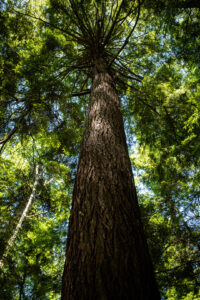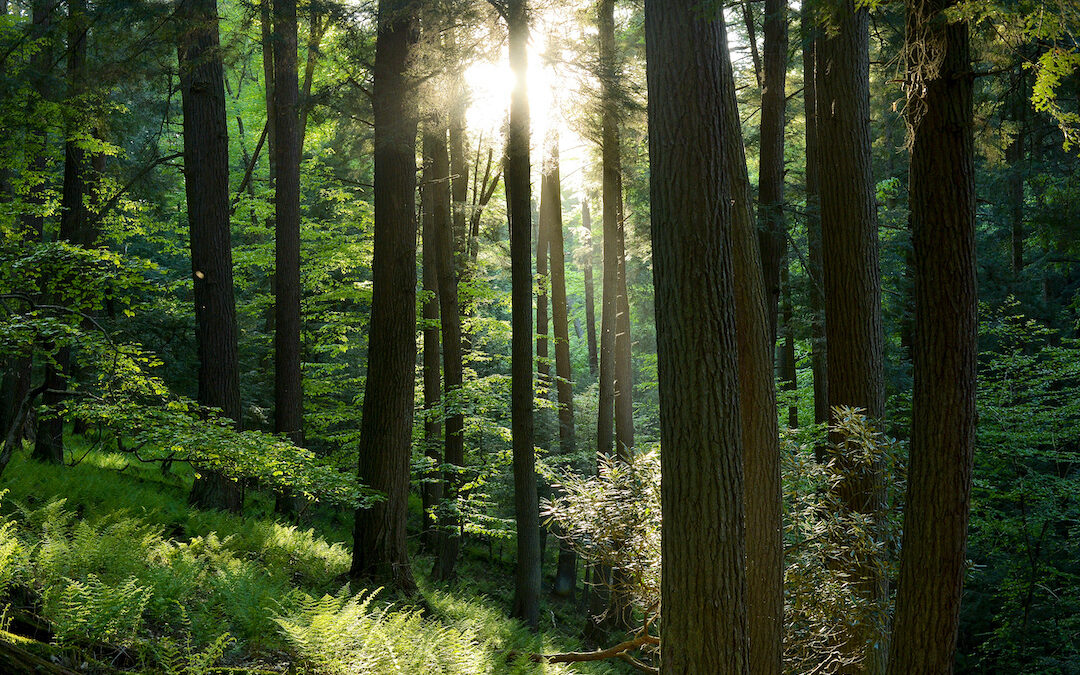Author’s Note: Would you join me this month to celebrate my love affair with the natural world? During May, I’m devoting most of my social media posts and all of my stories here to exploring my lifelong connection and love of the natural world, sharing the lessons of the mountains, the forest, the sea and the garden.
Pennsylvania’s forests — mostly clearcut more than 100 years ago — offer lessons in strength, resilience, and stewardship thanks to the restoration and management of the last century.
In the patches of rare, old-growth forest, like Cook Forest in Northwest Pennsylvania, there is an even deeper, richer peace to be found at the small spaces below tall, ancient trees — thanks to the conservation ethic of the Cook family.
When John Cook settled near the Clarion River in 1828 and began his logging career, he intentionally left many of the area’s towering white pines and hemlocks alone. So did his son, Anthony, and his grandson Anthony Wayne. When I needed a peaceful, restorative getaway, I went looking for it in this rare, 379-year-old forest.
We’re standing among Cook Forest’s ancient trees, walking down the hillside toward the Clarion River. All around us climb old hemlock and pine. We pause at a hemlock with a four-foot thick trunk soaring from a base of splayed roots, some more than a foot thick. The moss-covered roots, a mini-cathedral among the lichens and ferns, spark my curiosity about all that must live here – biological and mystical.
Long before I knew Cook Forest, I imagined its magic. As a child in Ohio, I knew it as the destination where my parents honeymooned in June 1969 at a family cabin. A happy time in their short marriage, presumably.
Forty years later, feeling desperate for peace and restoration, these centuries-old, mystical trees whispered to me.
There, waiting in the deep stillness and gentle snowfall of a fresh year, were ancient trees – a rarity in the Northeast, where lumbering cleared most of the virgin forests more than a century ago. The Eastern white pines in the Forest Cathedral tower 200 feet into the sky. Inside their fat trunks are the telltale tree rings marking 300 to 400 years of growth.
To be among the ancients, aware of their silent tenure, felt deeply peaceful and restorative. That first visit was the winter following my dad’s life-threatening illness over the Thanksgiving holiday, and just before our first makeup Thanksgiving dinner in mid-February, as the story goes. My core energy was depleted. I felt burned out.
I swooned for those majestic giants, soaking up their strength and quiet resilience, restoring my cup.
Then, I wanted to know their story.
A Spiritual Invitation
Dale J. Luthringer, the naturalist at Cook Forest State Park, and I hiked the Hemlock Trail through virgin forest one morning in January, 2011, a year later.
Luthringer has worked at Cook Forest for 27 years and is well-versed in the art and science of estimating the height and age of trees. Out in the woods, when pressed about why experiencing an ancient forest is worth the trip, worth the hike, Luthringer said this wild patch of Pennsylvania reminds him he is not atop the food chain.
“If you spend any time out here at all, it’s hard to not have a spiritual experience.”
Meaning: We humans are small.
Luthringer explains Cook Forest’s claims-to-fame: easily accessed old-growth stands (some ancients can even be seen from the car), year-round forest recreation, the Clarion River and a slew of tall-tree records. The Northeast’s tallest American chestnut, black cherry, Eastern hemlock, pitch pine, white oak and witch hazel all live here, along with Pennsylvania’s tallest American beech, big tooth aspen and Eastern white pine.
Cook Forest attracts foresters and scientists, tree-geeks, -lovers and -huggers – and travelers unaware they are in a forest virtually untouched since its birth after a 1644 wildfire. Some trees survived the fire and date to the early 1500s. There are 11 old-growth areas in the park, totaling more than 2,300 acres.
If not for the foresight of the Cook lumbering family — an exception to the timber barons who cut down nearly all of Penn’s Woods through the 1800s to help fuel the building of the nation — the loggers would have taken these trees, too.
“Wasteful” and “reckless” is how the historical accounts call the wood-cutting practices of that era. “Rape and pillage” is how some state foresters described it when I spoke with them several years ago for a magazine feature story about training foresters to manage Pennsylvania’s forests.
Cook’s Conservation Ethic
The conservation ethic of the Cook family offered a different legacy — and gave us the chance to experience an old-growth forest cathedral. It feels different.
John Cook, early American settler and logger, his son Anthony and grandson Anthony Wayne Cook, all protected some of the forest as John found it. Anthony Wayne Cook led a national, 17-year campaign to save more than 6,000 acres, purchased by Pennsylvania in 1927. The history is detailed in “The Cook Forest: An Island in Time” full of beautiful photographs by Anthony E. Cook.
Atop a ridge along the Hemlock Trail, the result of this history is striking. Luthringer and I walked out of the dark, ancient forest of evergreen pine and hemlock into bright sunshine. This spot – likely clear-cut 100 years ago – now grows oaks – white, red, chestnut and black – among other hardwoods. The only green this winter day is in the curled-up leaves of a dormant rhododendron and some moss on the ground.
It’s a lovely young forest. Bright and shiny. Strong and reaching — a different sensation than the deep peace I felt among the elder trees.
Soon, we are back in the virgin forest, pausing at this pedestal of primeval roots. Along with the multiple layers of canopy and standing and fallen trees, these buttressed roots, explains Luthringer, are a sign of an ancient forest.

Cook Forest, Pennsylvania.
My identification is far less scientific: a sensation of smallness and awe. I imagine Cook Forest is magical in any season, but I found winter’s stillness a rich time for my deep, necessary renewal.
These days, I recharge on weekly walks with our dogs year-round on the trails of Rothrock State Forest, 97,000 acres of public ground spanning the mountain ridges of Huntingdon, Centre and Mifflin Counties.
Dr. Joseph Trimble Rothrock, born in Mifflin County where I now live, is known as the “Father of Forestry” for his successful vision to establish a school to teach sound forest management practices at Mount Alto that later became part of Penn State University.
We often visit the deep peace of an old-growth forest in the protected Alan Seeger Natural Area, part of Rothrock Forest, where virgin white pine, hemlocks and 20-foot rhododendrons — all bypassed by the loggers — still grow, offering their peace.
~~~


Now I want to take a trip to Cook Forest. Keep on writing. You know I am waiting for the next one.
Thank you for the beautiful story and some wonderful memories for me. Now I find more of that perfect peace here in the Blue Ridge of North Carolina. I thank the Lord for these natural cathedrals.
Hi Pauline: Yessss. Natural cathedrals also so good for the soul 🙂 Those Blue Ridge mountains … what a spectacular place. I’ve only had a couple of short visits there. Looking forward to visiting and exploring more. Thanks so much for being here. Take good care.
Thank you for your beautiful story. I love the forests, however, never had a chance to visit Cook.
Hi Paula! Thank you! Cook is a special place … and every forest I’ve met has been a peaceful place. Take good care.
Wow you have an adventurous life ! Very jealous that you have that much time to do this. I live in Parkersburg WV, and we have many areas to hike and explore but do you recommend anywhere closer to the south western PA area? Thanks again